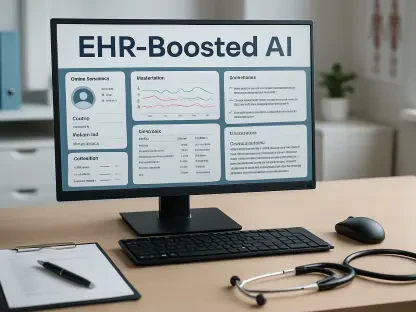In an era where access to healthcare increasingly hinges on digital connectivity, a groundbreaking tool has emerged to evaluate how prepared American communities are for the shift to virtual care, ensuring that disparities in access are identified and addressed. The American Telemedicine Association (ATA) has introduced the Digital Infrastructure Score (DIS), a data-driven benchmarking system accompanied by a detailed mapping platform. This innovative resource assesses telehealth readiness at both county and ZIP code levels across the United States, focusing on essential factors like broadband availability, internet speeds, device access, and affordability. By assigning relative weights to these variables, the tool provides a nuanced view of digital access, revealing stark disparities through an interactive heatmap. This development marks a significant step toward addressing the digital divide, ensuring that stakeholders can pinpoint areas most in need of support. As traditional healthcare infrastructure faces growing strain, such tools are vital for shaping a future where virtual care is accessible to all, regardless of geographic or economic barriers.
Bridging the Digital Divide with Data
The primary goal of the Digital Infrastructure Score is to illuminate the gaps in digital readiness that hinder telehealth adoption across diverse communities. With rural and urban areas alike grappling with inconsistent access to high-speed internet and devices, the pressure on physical healthcare facilities continues to mount. This tool offers a comprehensive analysis by integrating critical data points into a single, actionable score, enabling a clear understanding of where barriers exist. For hospital executives, health plan administrators, and policymakers, this resource serves as a guide to prioritize investments in digital infrastructure. It highlights specific regions where connectivity or affordability issues prevent effective virtual care, ensuring that resources are directed to the most pressing needs. Beyond mere identification, the platform fosters a data-driven approach to health equity, aiming to improve patient engagement by making telehealth a viable option for underserved populations who often lack nearby medical facilities.
Equally important is the role of the DIS in shaping collaborative efforts among various stakeholders in the healthcare ecosystem. By providing a shared evidence base, the tool encourages partnerships between public health officials, private entities, and community leaders to address digital disparities. The granular level of detail—down to ZIP codes—ensures that interventions are not broad and generic but tailored to local challenges, whether they stem from limited broadband coverage or economic constraints. This precision empowers decision-makers to craft policies and allocate funding with confidence, knowing that their strategies are rooted in credible, localized data. Furthermore, the platform supports grant applications and policy evaluations, offering robust evidence to justify investments in telehealth infrastructure. As digital solutions become indispensable in bridging healthcare access gaps, such a tool is critical for ensuring that no community is left behind in the transition to modern care delivery systems.
Empowering Stakeholders with Actionable Insights
The significance of the Digital Infrastructure Score extends beyond mere data collection, as it equips stakeholders with actionable insights to transform healthcare delivery. David Smith, Founder & CEO of Third Horizon Strategies and an advisor on this initiative, has emphasized the growing importance of digital tools in maintaining access to essential services amidst changes in physical healthcare access points. The consensus within the industry points to digital readiness as a cornerstone of contemporary care systems, especially as traditional infrastructure struggles to keep pace with demand. By offering detailed visualizations and user-friendly interfaces, the DIS allows health and community leaders to identify specific barriers—be it connectivity issues or device shortages—and address them effectively. This targeted approach ensures that telehealth can reach even the most remote or economically challenged areas, ultimately enhancing access to care for millions of Americans who might otherwise be excluded.
Another key aspect of this initiative is the iterative enhancement of the tool itself, reflecting a commitment to continuous improvement. Ann Mond Johnson, CEO of the ATA, highlighted that the updated DIS builds on frameworks from the organization’s CEO Advisory Group, incorporating expanded data sets and improved design features for better usability. Supported by a grant from the Peterson Health Technology Institute, the development process also benefited from the expertise of the CEO Advisory Group on Expanding Access to Healthcare, co-chaired by Kristi Henderson, Yasmine Winkler, and Ron Wyatt. Their contributions helped create a roadmap to tackle care pathway gaps through digital means. This collaborative effort underscores the tool’s potential to not only reveal the state of digital infrastructure but also drive meaningful policy changes and investments. By making digital readiness both visible and actionable, the platform sets a new standard for how telehealth strategies are planned and implemented across the nation.
Paving the Way for Health Equity
Looking back, the launch of the Digital Infrastructure Score by the ATA marked a pivotal moment in addressing disparities in telehealth access. The tool’s ability to provide localized insights into broadband availability, device access, and affordability offered a clear picture of where digital gaps persisted, empowering stakeholders to act with precision. Its heatmap interface and detailed data analysis illuminated challenges in both rural and urban settings, ensuring that no community was overlooked in the push for virtual care adoption. The collaborative spirit behind its development, involving industry leaders and advisory groups, set a strong foundation for impactful change, reinforcing the importance of data in modern healthcare planning.
Moving forward, the focus should shift to leveraging these insights for sustained progress in health equity. Stakeholders are encouraged to use the DIS as a blueprint for strategic investments, prioritizing areas with the greatest need to ensure telehealth becomes a universal option. Policymakers can draw on this data to craft legislation that supports broadband expansion and affordability programs, while healthcare providers might explore partnerships to distribute devices in underserved regions. As digital solutions continue to redefine care delivery, maintaining momentum through regular updates to the tool and fostering cross-sector collaboration will be essential. This initiative laid the groundwork for a more inclusive healthcare landscape, and the next steps must build on that legacy to guarantee safe, affordable, and accessible virtual care for every American.









